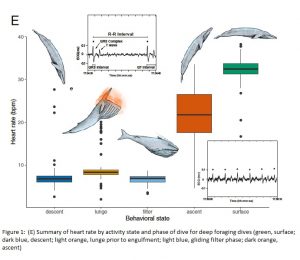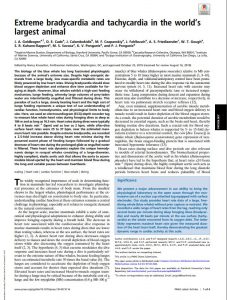Measuring heart rate to assess the stress response in large whales
Overview:

Marine mammals are being increasingly exposed to a complex suite of direct and indirect anthropogenic disturbances including climate change, noise, sonar, and ship traffic. New tools are needed to assess the impact of these possible stressors on physiological systems, particularly for cetaceans, which remain some of the most vulnerable and poorly understood marine mammals. Despite decades of tag studies on large cetaceans, very little is known regarding the diving physiology of these animals in either nominal or stressed states. The proposed research represents the first attempt to develop tools that will directly monitor heart rate in large free-ranging cetaceans. Heart rate is a key physiological parameter that is relevant to the stress response. Indeed, based on recent research in seals and dolphins, it has been suggested that cardiac arrhythmias may occur in marine mammals due to sympathetic – parasympathetic system conflict during stress (Williams et al., 2015a). This type of research is now possible because of the development of new tagging and bio-logging technology.
 In the proposed project, heart rate and kinematic data from large whales will be collected and analyzed using suction-cup attached digital tags. Past work with multiple large whale species has established our team’s ability to successfully deploy kinematic recorders and analyze the complex data from these animals (Goldbogen et al., 2011). Depth, acceleration, swim speed and other kinematic variables all provide insight into the animals’ behavior both during normal feeding activity and during sound/sonar exposure (Goldbogen et al., 2013a; Goldbogen et al., 2013b). The addition of heart rate data to such analyses will provide the basis of our investigations. This is critical because we must first understand the baseline physiological processes before we can fully assess how whales respond, both behaviorally and physiologically, to anthropogenic disturbance.
In the proposed project, heart rate and kinematic data from large whales will be collected and analyzed using suction-cup attached digital tags. Past work with multiple large whale species has established our team’s ability to successfully deploy kinematic recorders and analyze the complex data from these animals (Goldbogen et al., 2011). Depth, acceleration, swim speed and other kinematic variables all provide insight into the animals’ behavior both during normal feeding activity and during sound/sonar exposure (Goldbogen et al., 2013a; Goldbogen et al., 2013b). The addition of heart rate data to such analyses will provide the basis of our investigations. This is critical because we must first understand the baseline physiological processes before we can fully assess how whales respond, both behaviorally and physiologically, to anthropogenic disturbance.
Check out our current publication on this research here.